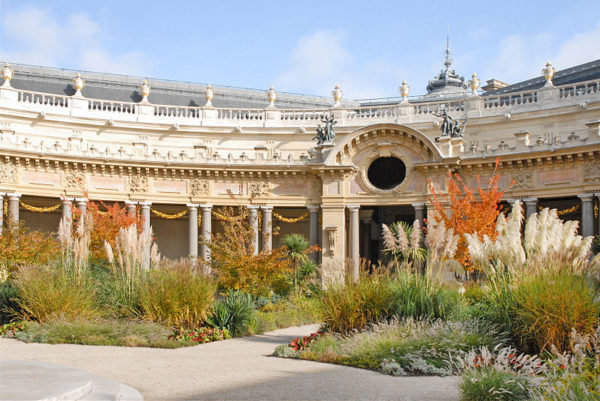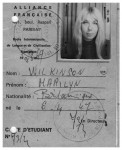The Petit Palais and its Hidden Courtyard Garden
- SUBSCRIBE
- ALREADY SUBSCRIBED?
BECOME A BONJOUR PARIS MEMBER
Gain full access to our collection of over 5,000 articles and bring the City of Light into your life. Just 60 USD per year.
Find out why you should become a member here.
Sign in
Fill in your credentials below.
Everyone has their favorite place in Paris, be it a building, church, street, garden, bridge or museum. Finding beauty in Paris is like looking for sand on a beach, but there will still be a special place that draws you back again and again. It’s impossible to compare or quantify beauty when it becomes– for whatever reason– personal to you. It may tug at your heart strings, thrill, or be a place of solace; or if you are lucky– all three.
I have always loved Le Petit Palais: its stunning architecture, quiet beauty, intimacy, refined elegance, and disparate collection of paintings. Who cannot be knocked out by the huge painting of Les Halles by Léon Lhermitte, not to mention the collection of Impressionist artists? Sitting at the bottom of the Champs-Élysées in view of the astonishingly divine Pont Alexandre III, Le Petit Palais is a miniature version of its glass domed sister, Le Grand Palais, situated just opposite. As if all this was not enough for a museum, Le Petit Palais hides another secret inside its walls:
The most beautiful courtyard garden in Paris, guaranteed to soothe the soul.

Image credit: Facebook, Petit Palais, musée des Beaux-arts de la Ville de Paris
Entering the courtyard is like taking a huge breath and exhaling slowly. This is another world, a microcosm of peace, beauty and tranquillity, and thank God, a cafe to take your coffee and sit under the covered walkway on iconic Parisian metal chairs spaced around small, circular dark green marbled tables, with the best outlook imaginable.
The cafe offers breakfast, brunch and lunch as well as pastries and cakes. All can be eaten inside the cafe or in the garden.
The semi-circular courtyard garden portico has a vaulted ceiling designed by Paul Baudouin who studied under the famed Puvis de Chavannes. It was Chavannes who reinvented the art of fresco painting that had long gone out of fashion. Above you is a huge vista of vines interspersed with medallions featuring the months, days and hours of the year and three large allegoric sections of the seasons. In Beaux Arts style and in rich decorative relief, the courtyard is enhance by pink granite Vosges columns encircling three ponds tiled in blue and gold. The garden floor was created by Facchino, the famous Italian mosaic artist, and is decorated using little blocks of marble. Above, gold swags and garlands frame two blue Sèvres porcelain vases on plinths.
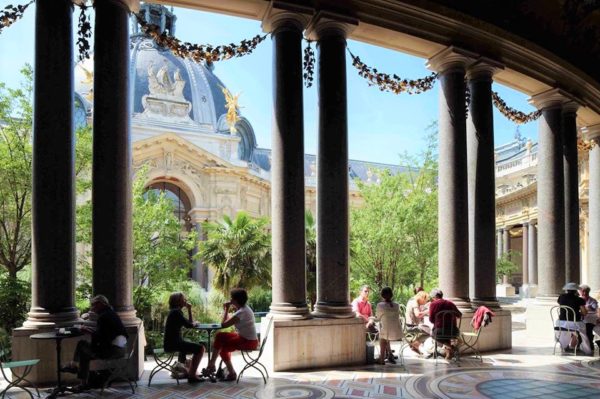
Image credit: Facebook, Petit Palais, musée des Beaux-arts de la Ville de Paris
All this in the lushest of gardens almost tropical in their planting. I have to confess to being useless at naming plants. I knew the palms and the cherry blossom trees but have relied on a gardener’s article, ‘The Dahlia Papers,’ to name some of the rest: Fatsia Japonica, Acanthus, Euphorbia, Bergeni, Yucca, Pampas grass, and other grasses, Magnolia Grandi Flora, even Banana trees– as well as the magnificent palm trees, of course.
Le Petit Palais was the result of a competition held in 1894 for the 1900 Exposition Universelle. The architects’ brief was extremely and unusually loose. The Palais de L’industrie from the 1855 World’s Fair on the site, was now considered unfitting, and architects could design what they wanted, even destroying the original building if they so desired.
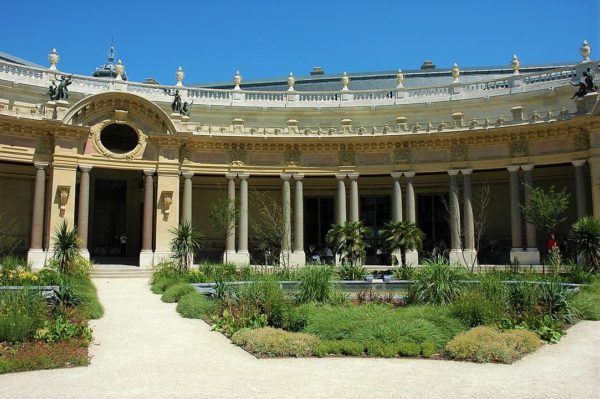
The interior courtyard taken in 2006. Image credit: Wikipedia, Patrick Giraud. CC BY 2.0
Charles Girault won the competition and the Palais de L’industrie was no more. Construction of Le Petit Palais began in 1897 and finished in April 1900. Girault drew his inspiration from 17th and early 18th century French style. Reflecting Beaux-Arts tenets, Le Petit Palais is a trapezoid shape; its longer side, the main facade, faces Le Grand Palais opposite. The courtyard garden is perfectly placed at its center.
Its dome, ionic columns and grand porch echo that of Les Invalides across the river. Jean Antoine Injalbert, who sculpted the figure on the Pont Mirabeau, was responsible for the tympanum and its muses. Injalbert was only one of many sculptors who worked on the outside of Le Petit Palais; others included Hugues, Peynot Ferrary and Desvergens.
The museum is beautifully light. Huge arched windows surround the building and the three outer galleries. Skylights illuminate the paintings from above and the carved white marble domed ceiling reflects even more natural light onto the white marble floors.
In January 2013, Le Petit Palais was one of 14 museums in the public corporation of Paris. It had already been listed in 1975 as an historic monument by the French Ministry of Culture.
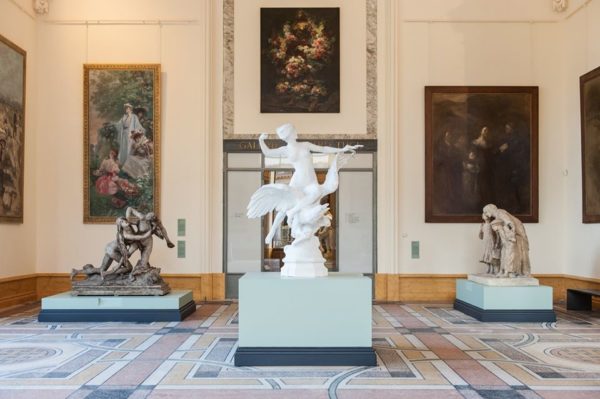
Image credit: Facebook, Petit Palais, musée des Beaux-arts de la Ville de Paris
On two floors, the museum houses a collection of medieval and Renaissance drawings, paintings and objets d’art, a collection of 18th century furniture, an impressive collection of 19th century paintings and sculptures from the likes of Géricault, Delacroix, Monet, Modigliani, Cézanne and Rodin as well as classical paintings from Rembrandt, Poussin and Fragonard. A small collection of ancient Greek and Roman art complete the collection.
By now, if you have walked both floors, you must be at least thirsty, and the garden cafe courtyard, with its hungry sparrows, is waiting to refresh and charm you.
Le Petit Palais is free. (Only temporary exhibitions have an entrance fee but the rest of the Le Petit Palais permanent exhibits are still available without charge.) Many Parisians simply pop into the cafe for a quick lunch or a quiet coffee away from the noise and bustle of the Champs-Élysées. Take a book, grab a coffee, or something more substantial and just sit and chill, soaking in the beautiful architecture and greenery surrounding you.
I might even be at the next table…
Le Petit Palais
Avenue Winston-Churchill, 8th arrondissement
Open Tuesdays-Sundays. 10am to 6pm
Entrance Free.
Tel: +33 (0)1-53-43-40-00
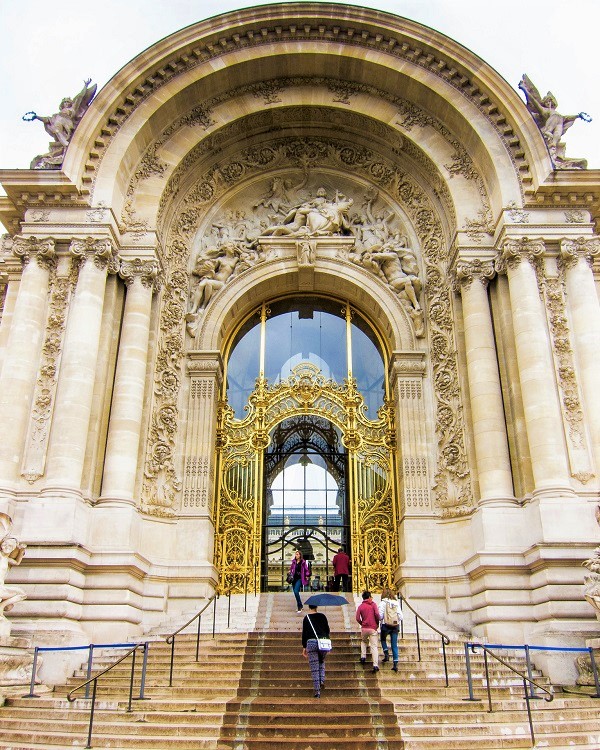
Image credit: Flickr, Martin Robson
Lead photo credit : Petit Palais. Image credit: Flickr, russavia. CC BY 2.0
